The revelers which fill the stairwell of Brecht Evens’ cover painting seem like a code for the contents of his book, ever striving for the space which occupies the right topmost corner of that image. They are dressed as for a masque: a conga line of harlequins, butterflies, angels, fairies, gauchos, ballerinas and Greek gods; ancient bacchants holding fiddles and rattles, sitting astride tandem bicycles and hobby horses; leaching on to the front and end papers of the book design, an account of the history of gaiety and debauchery.
As with the divided space of the book’s cover, Evens’ tale is performed in three acts and a coda. The ten guests which we see arriving at Gary’s apartment in the opening pages of the comic are about to discover they have arrived at the “wrong place”. The fault lies not with the host for he has been meticulous in his preparations: bottles of wine and spirits have been laid out for consumption; vodka has been chilled in the freezer; the hors d’oeuvres laid out neatly on flat serving trays. New seats from Ikea have been purchased for the visitors, their configuration conforming to the owner’s passion for predictability and practicality.
A party game is initiated and an awkward silence descends upon the group. The interactions suggest Beckett by way of Woody Allen. The negative space which borders these exchanges have a hint of Jules Feiffer. A perfectly congenial soiree spoiled by the fact that the anticipation of the group is not for the host but for his childhood friend, Robbie, an expectant and missing guest who has an indefinable and mythical allure.
An empty seat betrays his absence.
Like disciples awaiting the risen Christ, their muted conversations never stray far from this overarching fascination. They speak in cloistered groups jealously guarding their communication, quietly yearning for his return. Their stories concern thaumaturgy and legendary tribulations: a night club transformed by his miraculous touch into a haven of exquisite sin; …
… a wife accidentally shot in a hunting accident when mistaken for a duck (a tale once ascribed to a fellow guest now grafted indelibly on to Robbie’s legend). The cult is only dissolved when the eschatology is dismantled through a series of despairing phone calls denying his advent.
In an interview with Sean T. Collins, Evens explains one point of origin for his comic:
“I got started on the right track by looking at a book of early 20th-century Georg Grosz drawings, Ecce Homo. There’s a lot of cityscapes with skewed perspectives. In one of them there’s a prostitute sitting on a chair, viewed from behind. She’s all dressed, but through the back of the chair you see her naked. A lot of what I now do in my drawings comes from that, the transparency, see-through walls, people, things…”
[Dusk, George Grosz]
The influence is unmistakable and seen right from the outset: the overlapping colors and translucent forms congealing in the crush of a subway train, then processed into solid blocks to denote a physical and emotional separation.
There are crevices allowing us access into a world of voyeurs; a myriad figures moving dynamically and chaotically through the streets on a canvas divided by architecture and light – a purulent dissemination reiterated in the crush of Evens’ compressed and overlapping cityscapes less Grosz’s anger and pessimism; here replaced with a gaze which is hallucinogenic and addictive, seemingly acquiescent to the allure of modern living.
[The City, George Grosz]
An intrinsic part of the experience of perusing the first chapter of The Wrong Place is the act of rereading; a process which allows readers to find their way across a page where the dialog is arranged in staggered horizontal pairs; to make sense of the disassociated words which border a scene in a sitting room. While these words are color-coded to the attire of the characters, their sources often remain hidden, the voices severed from any person except in retropsect.
In a purposeful disregard for sequence, the reader’s eyes are led up and down a stairwell probing for markers to identify Gary’s visitors, searching for their likenesses in the people traversing the streets of the city earlier in the book.
It is as if we were guests at the gathering ourselves, discovering names, understanding histories, sharing in the social floundering. The experience is halting, uncomfortable and occasionally humorous, a stark contrast with the relative ease with which we glide into Robbie’s world in the second chapter. It is here we find Naomi’s long journey into the arms of that “lothario”. She is permanently attired in red…
…and we first see her bumping into Gary in a subway train on the fourth page of Even’s book, cowed by the crush of commuters and even less socially adaptable then that failed host. We only make the connection between this figure and the woman preparing for a night out in the second chapter through their shared flower-print coat. Her friend and personal dresser is bedecked in the green absinthe which emanates from the Chinese and Moroccan lamps that hang from the ceiling of the club they decide to visit. Their separation is inevitable and swift.
The crimson hue of Naomi’s dress allows us to chart her solitary progress though this dimly lit wonderland…
…a world of confusion and paradox which Naomi traverses like a Penrose staircase, a mystery created by the chronological plasticity of panels in sequence.
That blush of skin and clothing suggest not only a sense of displacement but also a permanent state of embarrassment, arousal and lust. No surprise then that she is seized upon by Robbie as a nymph by a satyr.
It is an effortless seduction and her euphoria is mirrored in the colors which gradually infiltrate the once opaque club.
Robbie’s irresistible charisma is revealed through his words, his actions, and the seduction of the artist’s brush; an instrument which turns the simple act of covering Naomi’s eyes with one of her stockings into an evocative mix of shadow, color and tone; …
… a touch which molds a simple indoor garden into a lush haven of music, light and forgotten memories, …
… and transforms a flash of ecstasy into a mesmerizing series of stuttering chromatic lines and washes.
It is not Robbie who seduces us with his conversation, physique or sartorial sense but each level of the club he calls his second home, each saturated with the exotic aromas of food, intimacy and orgiastic sex. This is where Evens succeeds so thoroughly in The Wrong Place, these acts of enchantment which allow the reader to grasp with ease the utterly addictive nature of Robbie’s world.
When the moment is over, Naomi lies back in her bed fully sated. The bedside lamp is switched off and for the first time she is swallowed, body and soul, by the vacant darkness…
…that same shroud which envelops Robbie at the close of the first chapter.
Her partner lies quietly by her side in bed, his form suggested by the folds in the sheets, her solitude emphasized by the absence of any other clear signs of his presence or humanity. In this illusive play of light and shadow it is never entirely clear whether her lover remains with her or has already departed, whether the pleasures which preceded this point were the products of hallucination or reality, whether she has in fact arrived at the right place.
This sequence towards the close of the second chapter is described by Evens as a “joyride ending in separation and anticlimax“, a prelude to a similar moment which closes the third chapter of this book. This last chapter is largely expository in nature and overlaced with metaphor. There is a long conversation between Gary and Robbie in the bowels of the cavernous club and then the suggestion of a choice between adult responsibility, and childhood contentment and freedom. The decision to make Gary’s new job that of a playground manager perhaps pushes this idea too far where more subtlety would have been preferable.
Robbie is, of course, the boy who never grew up, an incandescent child without a single inhibition. His club, the “Disco Harem”, is a chic Neverland filled with pirates, Indians and other exotic creatures; a world filled with the kind of “wonderful thoughts” that allow people to fly, a type of intoxication which Gary is unwilling or unable to partake of.
He can only stare down at gathered crowd, this confluence of childhood memories and desires, like an administrator. For an instant, he almost dares to join them.
Then the moment is over …
…and he is crawling back into a familiar geometric darkness. His back is turned towards us as he traverses a passageway heavy with eyes of expectation.
The last we see of him is a shape bowed down and cast in black and white; just like the barely discernible “party animals” of his youth who look back at him in portraits lining the exit, all shaded in dusky uncertainty, all tired, old and dull.
NOTES
(1) Reviews by Derik Badman, Robert Boyd and Sean T. Collins
(2) Interviews conducted by Sean T. Collins and Frank Santoro (includes detailed notes on working methods)
(3) An analysis of a single page from the comic by Greice Schneider

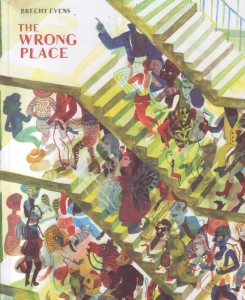
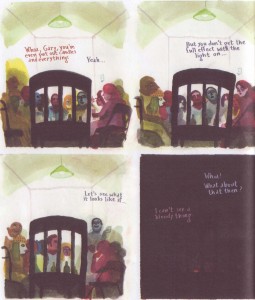
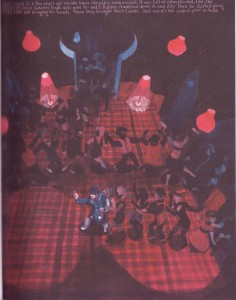
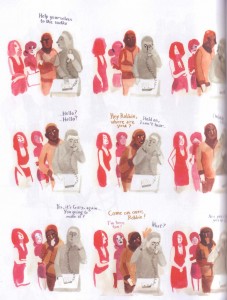

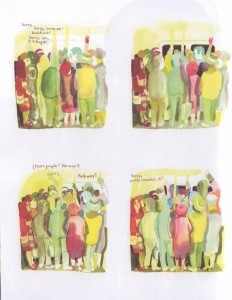
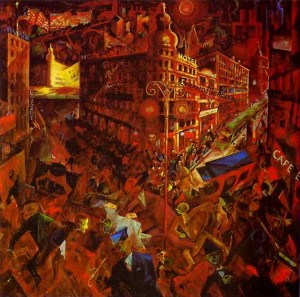
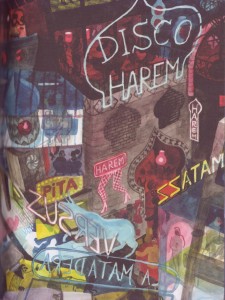
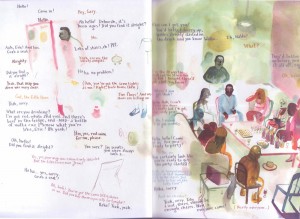
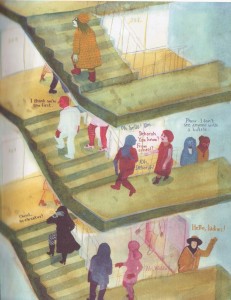
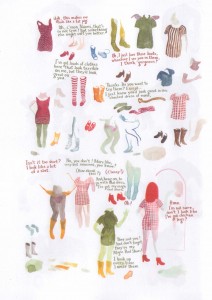
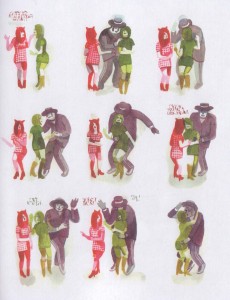


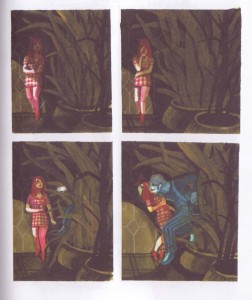

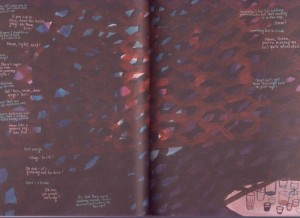
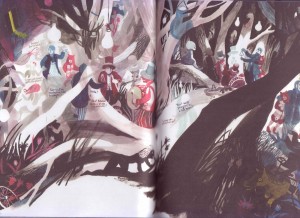
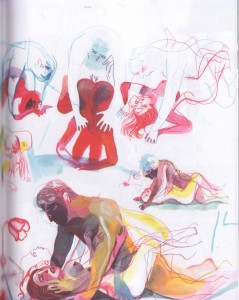
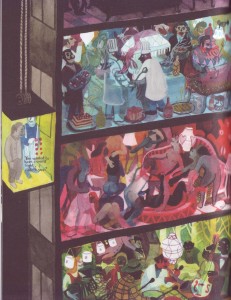
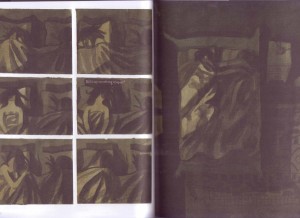
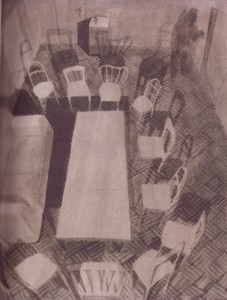
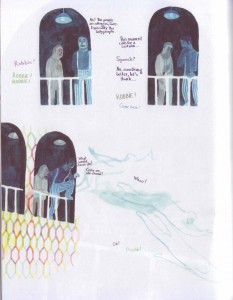
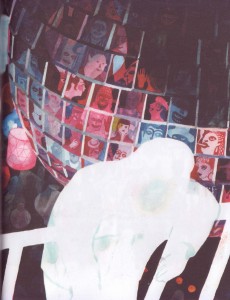
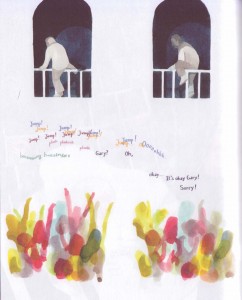
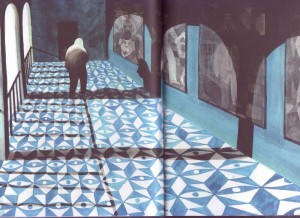
It’s interesting…Naomi looks a little like Hanna from Asterios Polyp, and seems to occupy a somewhat similar place in the narrative (the woman seduced.) Not sure quite where to go with that since I haven’t read the Evans…I guess I’d wonder if the sophistication of style dovetails with a particular take on gender roles….That is, maybe, are both the gender roles and the style in the interest of the sophistication?
What i like of what’s shown here is the unabashed sensuality of the art and story, even with a bittersweet coda. Rare in comics.
(Ak! Did I actually use the word ‘bittersweet’? On my list of critical clichés to shun, along with ‘taut’, ‘luminous’, and ‘epiphany’. Ah, well, it’s the end of the week and I’m tired…)
Noah: I don’t think the comic has anything especially new to say on gender roles. Like Alex suggests, the most interesting aspect here is its depiction of a certain kind of lifestyle (through place and person). The artist’s “voice” is convincing in that respect whereas in many other cases the reader has to suspend belief. The art is “sensual” and also has sufficient form & suggestion to allow the reader in.
The woman is pretty passive throughout but so is virtually every single person who encounters Robbie. On one level, the comic could be described as a catalog of reactions to Robbie and the places he inhabits; so much so that he becomes an archetype of sorts. Hence Frank Santoro’s identification of him with a Greek god.
On gender roles: I recently rewatched “Deep Red” on the new Blu Ray release (because you mentioned Suspiria a while back), and I must say that the film is filled with lots of intentional (and unintentional) riffs on gender roles both in reality and on film. Seen it?
Alex: Those words aren’t half as common as “great”, “brilliant” and “masterpiece”.
Damn, I was all set to describe this great post as a brilliant masterpiece. Oh well…
Thanks for writing about this book though. Quite lovely art at the very least.
I haven’t seen Deep Red! Just put it on Netflix though….
I wasn’t suggesting that it had anything new to say…just sort of wondering how it fit together, if at all with AP… The archetypes sort of suggests another connection….
Just make sure it’s the 2 hour version!
another bonus to Deep Red is the killings set to Goblin songs
agree with Ng re cut. the 4 hour version is almost unwatchable
Pingback: paddybrown.co.uk » Blog Archive » Eagle Awards open for nominations
Pingback: Panelinks: 2-25-11 | The Panelists